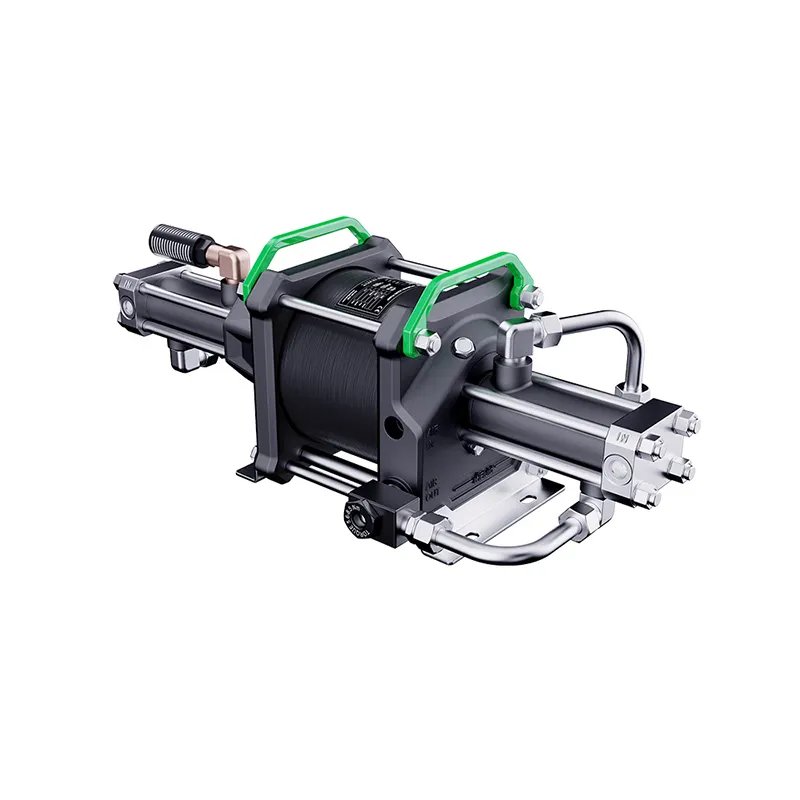What Are Air Driven Gas Boosters?
Core Components and Working Principles
Air Driven Gas Boosters are indispensable tools for efficiently boosting gas pressure in different applications within the industrial production lines. These have the ability to increase pressure of the gas by the applications of the compressed air which have made them useful in areas where it is necessary to have controlled high pressure gas. The booster contains several important parts which include the air motor, gas piston, and multiple valves. They all cooperate together to change low pressure air to high pressure gas out put. Mechanical energy is produced by the air motor, causing the gas piston to compress the gas effectively. This knowledge enables industries to streamline processes in such a way that energy consumption can be minimized and overall effectiveness can be improved.
Types of Air Driven Gas Booster Systems
Air driven Gas booster systems are available in a variety of types and pressure ranges and can be assembled to meet most air pressure requirements and design specifications. They are primarily single stage, and multi-stage boosters. Single-stage boosters are smaller and used in applications requiring moderate pressures, such as laboratory environments. Multi-stage system, on the other hand are designed to deliver more pressure increases, usually required for industrial applications. Each comes with its own set of use cases, be it low or high-pressure applications. It’s critical to choose a suitable type of gas booster for the best performance. This selection directly affects efficiency, prevents overpressure problems and keeps system operation within the defined range.
Enhancing Safety in Gas Handling with Gas Boosters
Built-In Safety Mechanisms for Hazardous Environments
Air gas boosters are safety rated with features like pressure safety relief valves and automatic shut off systems for hazardous applications. These means are particularly important to regulate gases release in alteration pressure situations and in respect of the safety of use. Quality is insured by adherence to the most stringent standard safety features, which minimize accidents and keep the accident rate of workers very low. The implementation of such safety features led to a notable reduction of gas leaks and failure of systems. This product not only protects workers, but also extends the life of your equipment to be used in harmful environments.
Reducing Leak Risks Through Precision Pressure Control
Accurate control of pressure is very important in air driven gas boosters, as it is directly related with the leak preventive measures. These systems are designed to deliver consistent pressure to help stabilize variances, which can result in mechanical stress, deficit wear and possible leakage. Through the use of sophisticated control technology including sensors and feedback loops, gas boosters have the ability to adjust to changing environmental conditions providing improved process control. Studies demonstrate that good pressure management can reduce the amount of maintenance and breakdowns that can be caused by leaks, and in so doing, support a safer work place. This function not only reduces the risk of leaks, but also provides a sustained performance over time, which is a key element to maximize safety in gas handling applications.
Improving Operational Efficiency with Air Driven Gas Boosters
Energy-Saving Design Features
Air powered gas boosters offer a number of features all designed to save energy and increase efficiency. This features adjustable speed control and the proprietary airflow dynamics that reduces the energy consumption. The data shows that by adopting such energy-efficient schemes, energy can be saved of around 30% compared to the conventional gas booster systems. Reallifedata: By decreasing the amount of energy used, industries can save money and reduce their overall carbon footprint — two things that fit into a broader green business strategy. It is because of this that knowledge of these consumption trends becomes of vital important for companies looking to increase their efficiency, while heavily cutting on running costs.
Maintenance Advantages Over Traditional Systems
One of the major advantages of air-drive gas boosters is that they require lesser maintenance as compared to conventional gas booster systems. Furthermore, owing to their simple construction and absence of complicated mechanisms, these models are less prone to malfunctions making them highly durable. With regular maintenance cycles minimized, companies save time and labor costs. In fact industry sources report that in many cases, organizations adopting air driven systems actually experience a reduction in total maintenance cost. This adds reliability – and translates into significant savings; making air driven gas boosters a sound investment for any business looking to operate efficiently.
Key Industrial Applications of Air Driven Gas Boosters
Oil and Gas Industry Use Cases
In the oil and gas industry, air-driven gas boosters are essential in boosting pressure in drilling and extraction operations. These booster are necessary for functions such as chemical injection, safety system actuation and pressure testing. They are also built to a rugged design for reliable performance with a minimum risk of failure, which is essential for pipeline conveyance and for emergency failsafe shutting down applications. For instance, the use of air driven systems is common for gas compression purposes in pipeline transport, because they are a reliable device for ensuring an uniform pressure of gas. Research has shown jthat adoption of air-driven gas boosters results in higher efficient and optimum performance and less air pollution.

Aerospace and Automotive Pressure Testing
Gas boosters powered by air are used in such critical areas as aerospace or automotive, where components and assemblies need to be pressure tested. They help to make the parts resistant to extreme conditions and compliant with tight compliance regulations. The accurate pressure control during testing is important for the security and compliance, resulting in the best service in field applications. Expert’s opinions Companies using air-powered systems in pressure testing experience greater precision in results, accelerated time to market for their new parts and a competitive advantage in the high-speed industries of automotive and aerospace.

Choosing the Right Air Driven Gas Booster System
Matching Pressure Requirements to Equipment Needs
Choosing The Correct Air Gas Booster System The right choice in Air Gas Booster systems begins with an understanding of your specific pressure requirement. This implies knowing the upper as well as lower limits of pressure required by your application to be satisfied that booster is working productively. Industry standards strongly advise the booster be specified to meet the specific requirements of your process. If it doesn't meet this then not only the machine is inefficient, but also the life of the system parts is shortened. Thus, the importance of accurate pressure requirements in emphasis to operational sustainability cannot be overstated.
Material Compatibility for Different Gas Types
Material compatibility is an equally important aspect of a safe, efficient air driven gas booster system. That’s because other gases might react differently with materials that the booster’s components, like seals and pistons, are made of, causing them to break down or lose integrity. The proper materials will also reduce the chances of chemical reactions that might prove hazardous and possibly cause the system to fail. More research on industry standards and compatibility charts in needed to avoid these pitfalls. There are certain studies which show that neglecting the influence of material compatibility can greatly elevate operational costs through an effect that might otherwise narrow the gap in the system selection process.
FAQs
What are air driven gas boosters used for?
Air driven gas boosters are used to increase gas pressure in various industrial applications, allowing for controlled high-pressure gas essential for certain processes.
What safety mechanisms are inherent in air driven gas boosters?
These boosters feature built-in safety mechanisms like pressure relief valves and automatic shut-off systems to ensure operational safety in hazardous environments.
How do air driven gas boosters enhance energy efficiency?
They utilize energy-saving design features such as variable speed controls and optimized airflow mechanics, significantly reducing energy consumption.
Why is it important to consider material compatibility in air driven gas boiler systems?
Material compatibility prevents chemical reactions that can cause degradation or leaks, ensuring safe and efficient operation.

